It’s our constant endeavor to update VMware Telco Cloud Service Assurance, and the new 2.2 release brings new features and improvements to enhance the user experience:
- Samsung vRAN assurance
- Remote Data Collector
- Data-driven mechanism for alarm management
- Enhanced tool for infrastructure planning
- Simplified demo deployment on a virtual machine for demonstrating capabilities
With this release, VMware Telco Cloud Service Assurance can discover Samsung vDUs and their underlying infrastructure with status monitoring. vDU Fault Management (FM) and Performance Management (PM) counters and events monitoring would be integrated.
The data collector components of the solution can be deployed on a remote data center, such as cell site, Distribution Unit (DU), or an edge node that is separated from the core services component. This remote collector node of VMware Telco Cloud Service Assurance gives administrators an added advantage to navigate through firewalls, reduce bandwidth across data centers, connect to remote data sources, gain access to monitor devices in a managed customer environment, and reduce the load on the core analytics clusters.
A new data-driven mechanism and simplified process for defining alarms and remediation rules makes it easier for administrators to manage closed-loop remediation and actions. This mechanism enables operators to make informed decisions by defining alarms and remediation rules that are based on live data collected across various layers of infrastructure and network functions. Data-driven decision making can help reduce the need for reiteration and rework to identify the right set of thresholds to create alarms and remediation rules. For example, you can create an alarm or remediation rule by querying all instances or selected instances of physical or virtual infrastructure of CPU utilization.
In addition, for sizing the infrastructure we have eased the process by transitioning to a spreadsheet based sizing tool along with the VMware Configuration Maximums (a standard tool for VMware solutions), which is in line with the VMware infrastructure planning process. The Configuration Maximums tool recommends configuration limits for VMware products.
We have developed a lightweight demo version of VMware Telco Cloud Service Assurance that can run on a virtual machine to help customers who don’t have Kubernetes deployment and who would like to have a hands-on experience before deploying the product in a production environment. The full version of VMware Telco Cloud Service Assurance is built on a cloud-native architecture powered by the VMware Tanzu Kubernetes platform.
Samsung vRAN Assurance
With VMware Telco Cloud Service Assurance version 2.2, we have enabled discovery and close monitoring of RAN sites that are running on Samsung vDU network functions. The discovery and monitoring of the underlying infrastructure components of the vDU are done through a combination of network management protocols, software-defined networking technologies, and network function virtualization (NFV) techniques.
VMware Aria Operations (formerly vRealize Operations) is the key component in the VMware Telco Cloud Service Assurance solution that is used for monitoring and performing root-cause analysis for failures in vDU deployments. A virtualized network function is measured on the Fault Management (FM) and Performance Management (PM) metrics that would be collected constantly through VMware Aria Operations. These measurements facilitate the closed-loop automation and remediation feature integrated with VMware Telco Cloud Automation to detect anomalies and correct issues in case of network failures.
Remote Data Collector
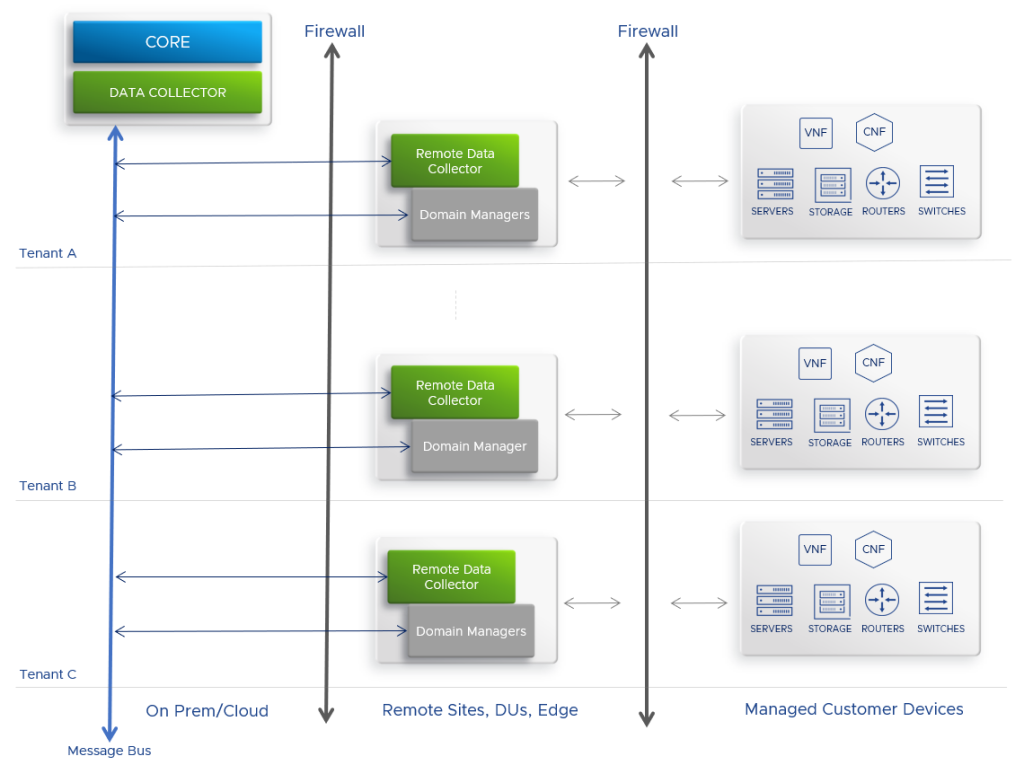
Network administrators who manage VMware Telco Cloud Service Assurance are now provided with a way to manage devices that are solely in a customer’s network, governed by strict security system rules. The Remote Data Collector allows you to deploy collectors and domain managers at remote data center locations. Once deployed, it allows seamless remote configuration and remote upgrade using central VMware Telco Cloud Service Assurance over a secured channel.
The collectors and domain managers can now be deployed on a remote data center for data collection purposes and the dashboard and reporting computations can happen at the core data centers. This distributed method of deployment and operations gives the following advantages:
- Distributed computing gives access to customer devices that are under strict firewall rules.
- With core services running on Kubernetes clusters and the remote collector installed on VMs, the solution can be deployed in managed customer sites without Kubernetes.
- Faster processing of data for information happens at a near-edge location where collectors are installed and interact with closer proximity end devices.
- A lighter footprint of remote collectors can now be deployed in customer’s data centers, which was earlier done with core and collector services running together.
- With aggregation and compression capabilities built-in, the core services can now manage monitoring and computations of larger sets of data from devices with a lower footprint of the installation. In this way, we have solved for potential issues which would occur because of higher network bandwidth and resource utilization at the core.
- The bidirectional communication between the core services and the remote data collectors is designed to function over a secured channel with only required ports opened for communication.
- Role-based access control (RBAC) governs access to multiple internal customer nodes from a single instance of VMware Telco Cloud Service Assurance.
Data-Driven Mechanism for Alarm Management
We listened to customers to enhance our service assurance solution to function on data-driven methods for solving problems based on analyzing and interpreting already ingested data. Administrators now have an advantage in configuring alarms and creating on-demand remediation rules based on live ingested data, manually from the user interface (UI). Furthermore, users can create on-demand remediation rules to send outbound notifications using email, Slack, or the ServiceNow ticketing system.
Here are a few examples to explain how the data-driven mechanism works:
- Users are presented with the capability to select and correlate one or more live events at a time, based on a real-time condition in the Notification Log view. This assists users in creating a customized remediation rule, such as triggering a remediation action in VMware Telco Cloud Automation, opening a ticket in ServiceNow, or sending a Slack message.
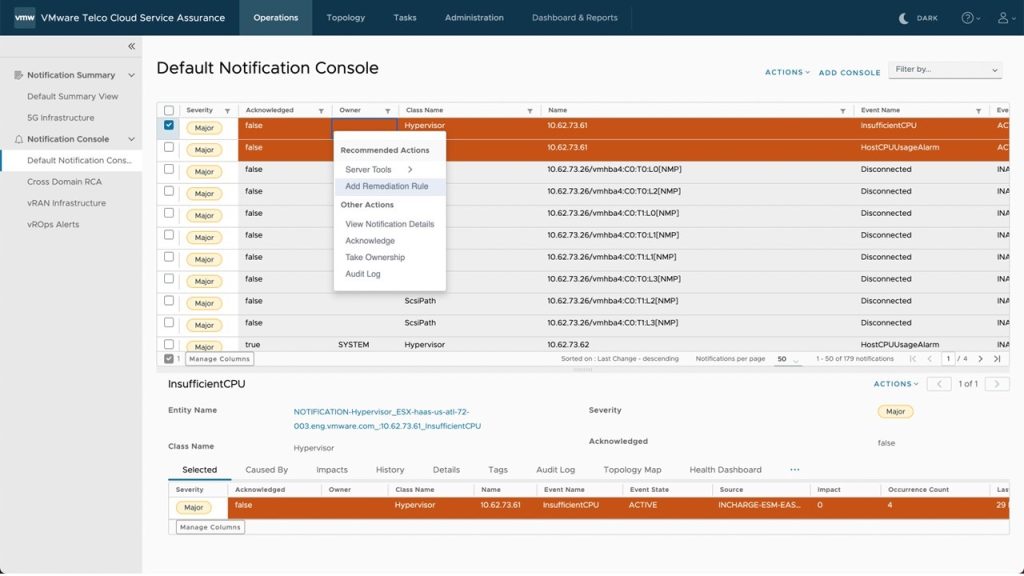
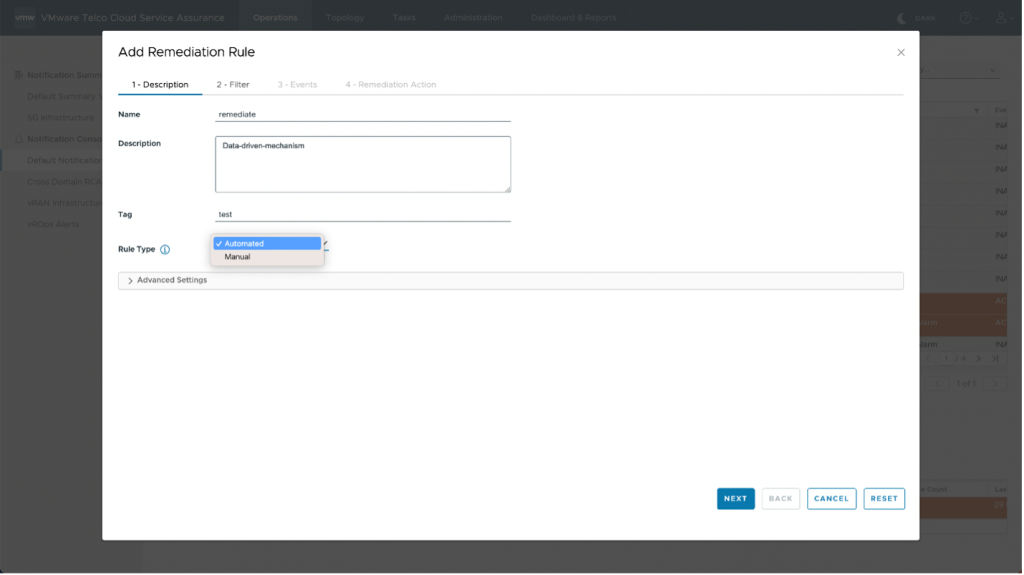
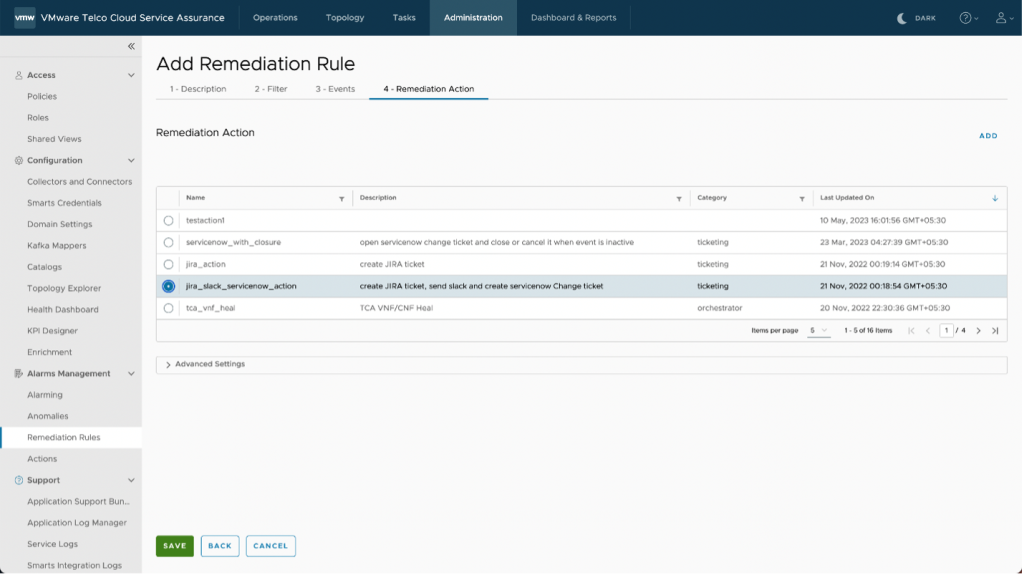
2. Users can now define custom alarms, conditioning it with multiple AND or OR operations, while filtering through the already available application or infrastructure data properties from the drop-down list. The data properties can be any of the ones belonging to devices, such as server hosts, routers, containerized network functions (CNFs), virtual machines (VM), location, and tenants. This saves time and reduces errors.
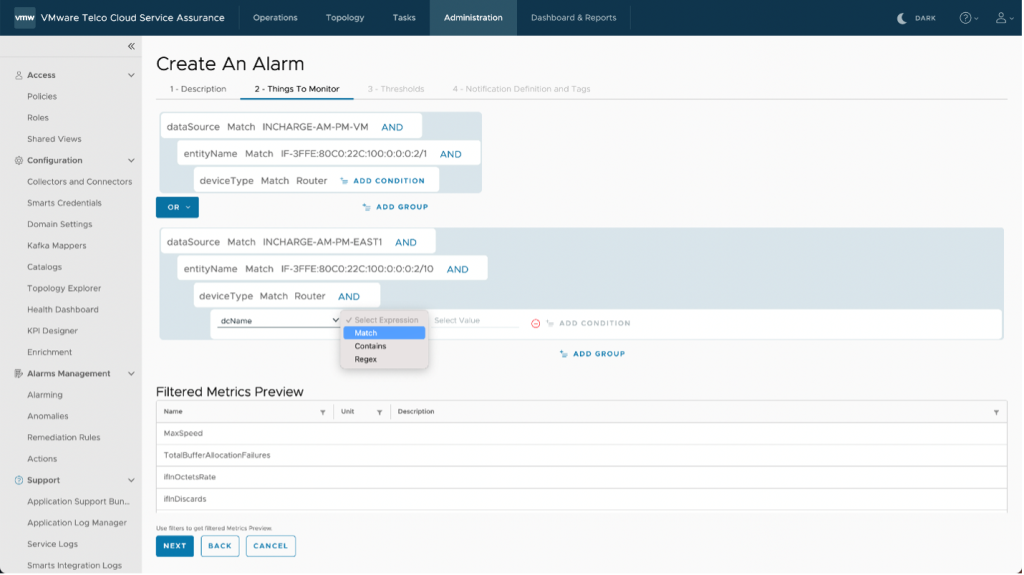
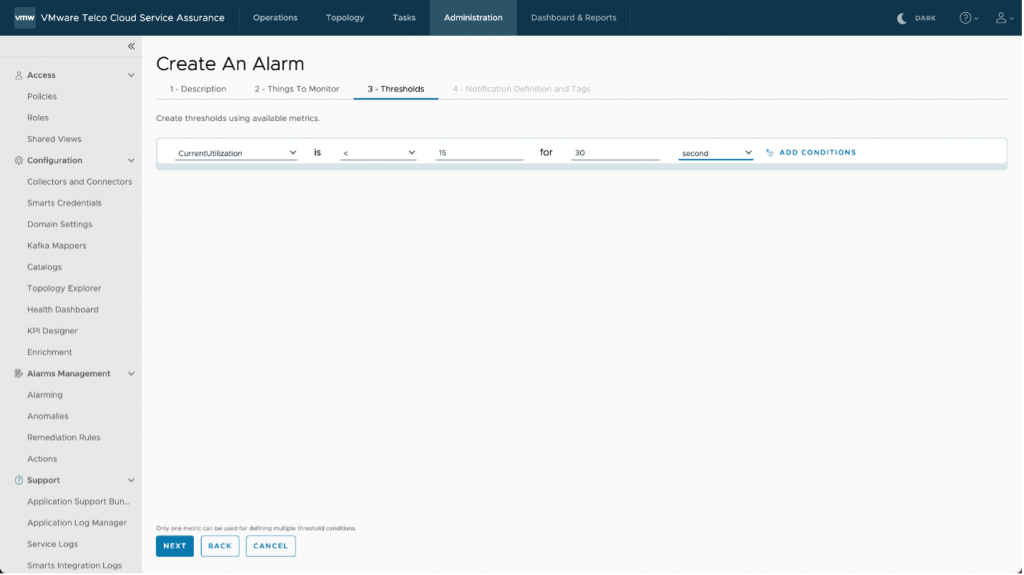
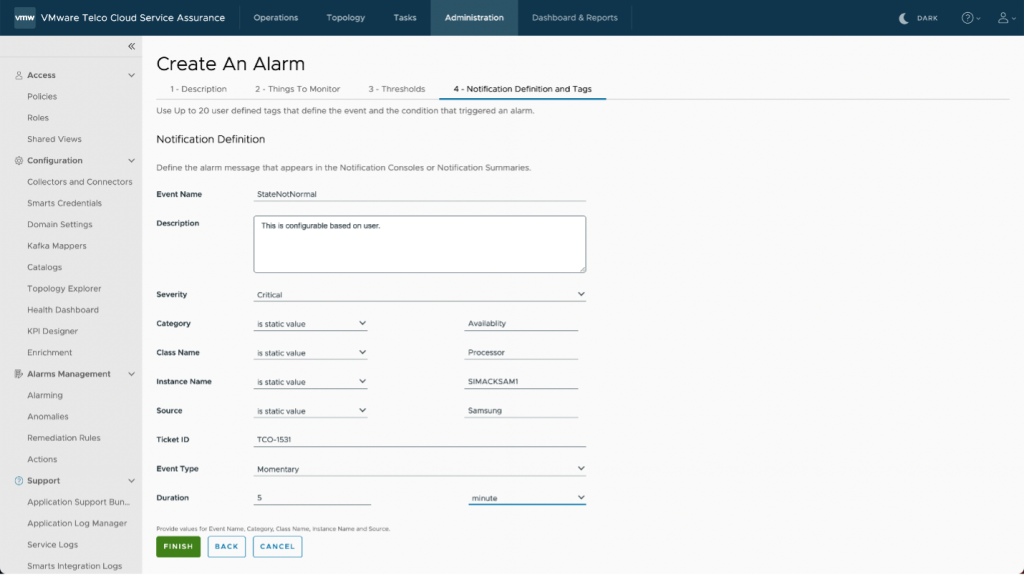
Enhanced Tool for Infrastructure Planning
We made enhancements to the sizing calculator sheet so customers can get better visibility of the footprint to be deployed and scale the solution based on future requirements, such as:
- Number of locations required for RAN sites
- Number of devices to be discovered and monitored
- Amount of data and metrics to be collected
After providing all the required information and configurations settings, the calculator will measure the size of the solution and provide the required footprint to support it. This includes the node’s configurations details of the Kubernetes management and workload clusters. The calculator is available in the product documentation.
In addition, we added VMware Telco Cloud Service Assurance to the Configuration Maximum portal for VMware products at https://configmax.esp.vmware.com/home. With the portal, customers can measure the maximum number of metrics supported by the core, collectors, and domain managers.
Simplified Demo Deployment in a Virtual Machine Footprint
Most customers have pre-production environments that are used for testing and quality assurance. To get firsthand experience with VMware Telco Cloud Service Assurance, we have simplified the deployment procedure so that the service assurance solution can be deployed on a virtual machine (VM). The VMs may be running on any underlying infrastructure, such as VMware vSphere, Red Hat OpenStack, or a Kernel-based Virtual Machine (KVM). The deployment procedure is fully automated and easy to run with a minimal set of prerequisites. This lightweight demonstration showcases a few of the many features in VMware Telco Cloud Service Assurance.
Migration from VMware Smart Assurance to VMware Telco Cloud Service Assurance
VMware Telco Cloud Service Assurance is built on a cloud-native platform to deliver functionality through microservices. VMware Smart Assurance customers may upgrade to VMware Telco Cloud Service Assurance to gain advantage of various features, such as the following:
- A scalable cloud-native platform
- Closed loop remediation
- An open data collection framework
- Enrichment, alarming and thresholding
- Anomaly detection and ad hoc reporting
- New TMF APIs
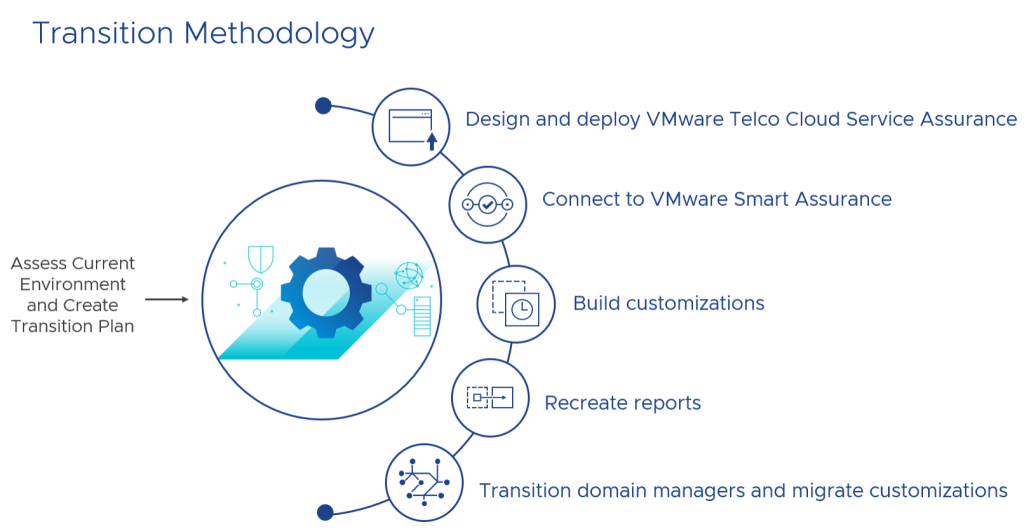
Software Versions and Interoperability
Supported versions for VMware Telco Cloud Platform:
| Product | Versions |
| VMware Telco Cloud Platform 5G | 3.0, 2.7 |
| VMware Telco Cloud Platform RAN | 3.0, 2.2 |
For more information on the list of software and interoperability versions for different products, see the documentation for VMware Telco Cloud Service Assurance at this link.
Conclusion
VMware Telco Cloud Service Assurance reduces costs and complexity for Network Operations Centers and Service Operations Centers by providing a single pane of glass for fault management, performance management, service management, network slice management, Root Cause Analysis (RCA), and service impact analysis in multi-vendor, multi-cloud environments.
The solution, which is built on a cloud-native architecture, delivers a data collector framework to support modern network transformation. Besides its built-in smart data collector, VMware Telco Cloud Service Assurance can collect data from third-party monitoring tools, including VMware Aria Operations, for virtual infrastructure and public cloud monitoring.
It enables closed-loop automation and remediation using the standard ETSI NFV-SOL interface for integrating with a standards-based orchestrator, such as VMware Telco Cloud Automation.
Discover more from VMware Telco Cloud Blog
Subscribe to get the latest posts sent to your email.








